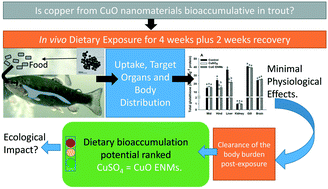Dietary exposure to copper sulphate compared to a copper oxide nanomaterial in rainbow trout: bioaccumulation with minimal physiological effects
Abstract
The dietary bioaccumulation potential of engineered nanomaterials (ENMs) remains poorly understood. The aim of the current study was to assess the dietary bioaccumulation of copper from copper oxide (CuO) ENMs or dissolved copper (CuSO4) exposure in fish. Animals were fed a nominal diet of 750 mg kg−1 Cu in the respective forms for 4 weeks, then fed the control diet for a further 2 weeks in a depuration phase. Fish were sampled at weeks 2, 4 and 6 for total Cu analysis. Samples were also taken at week 4 for plasma ions, biochemistry and histology. An in chemico digestibility assay simulating the gut lumen showed the total Cu could be leached (i.e., was bioaccessible) from both diets. Fish from all treatments showed normal growth and survival, and with healthy histology of gills, intestines and liver. At the end of the 4 week exposure, both Cu materials caused an elevated tissue total Cu concentration with the highest in the mid intestine, hind intestine and liver. For example, the week 4 liver total Cu concentrations were 82 ± 7, 259 ± 19 and 281 ± 17 μg g−1 in the control, CuSO4 and CuO ENM treatments, respectively, with no significant differences between the Cu exposures. Compared to the controls, both forms of Cu caused induction of MT in the hind intestine, as well as some depletion of total GSH in the liver. In the post-exposure phase, there was evidence of depuration of total Cu from the mid and hind intestine, and also the carcass, but not the brain or kidney. The liver also maintained similar total Cu concentrations, in keeping with this organ as a central compartment for Cu excretion. There was limited evidence of nanomaterial-specific effects. Overall, the CuO ENMs showed similar patterns of bioaccumulation to CuSO4, with negligible physiology effects.

- This article is part of the themed collection: Recent Open Access Articles


 Please wait while we load your content...
Please wait while we load your content...